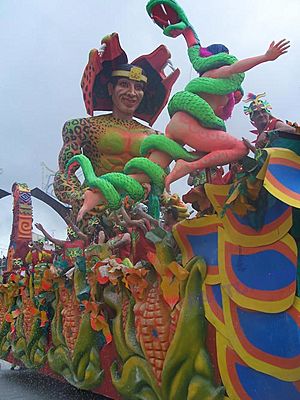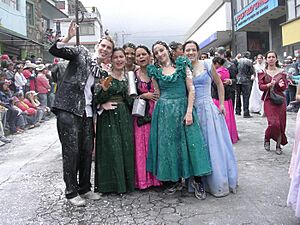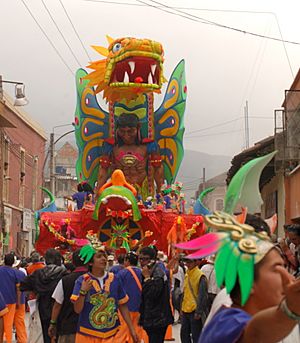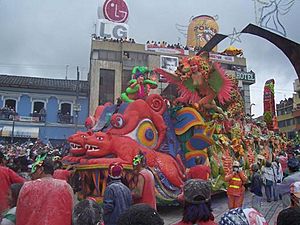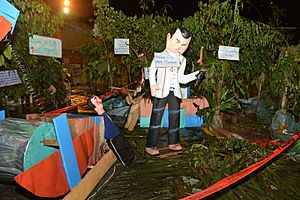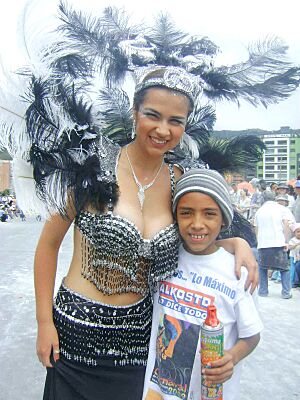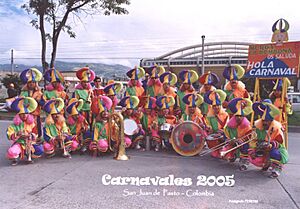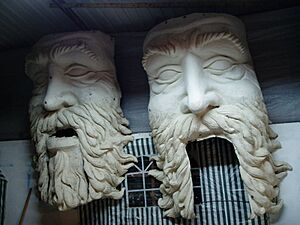Blacks and Whites' Carnival facts for kids
Quick facts for kids Blacks and Whites' CarnivalCarnaval de Negros y Blancos
|
|
|---|---|
| Nickname | Carnavales de Pasto |
| Genre | Carnival |
| Date(s) | 2–7 January |
| Frequency | Annual |
| Location(s) | Pasto, Colombia |
| Inaugurated | 1546 |
| Carnaval de Negros y Blancos | |
|---|---|
|
UNESCO Intangible Cultural Heritage
|
|
| Country | Colombia |
| Reference | 00 |
| Region | Latin America and the Caribbean |
| Inscription history | |
| Inscription | 2009 (4th session) |
| List | Representative |
The Blacks and Whites' Carnival (in Spanish: Carnaval de Negros y Blancos) is a huge public festival and parade in southern Colombia. It started way back in 1546! Even though it's mainly celebrated in the city of Pasto, other towns in the Nariño area also join in the fun.
This amazing carnival happens every year from January 2nd to 7th. Lots of people from Colombia and other countries come to see it. On September 30, 2009, UNESCO recognized this Carnival as one of the Masterpieces of the Oral and Intangible Heritage of Humanity. This means it's a very special cultural tradition worth protecting!
Contents
History of the Carnival
How the Carnival Began
The Blacks and Whites' Carnival mixes many different cultures. It brings together traditions from the Andes mountains, the Amazon rainforest, and the Pacific coast. It was first celebrated in 1546. This carnival is special because of its unique start date. It lines up with ancient celebrations of the Moon (Quilla) by the Pastos and Quillacingas people. These farming groups honored the moon during harvest time with dances. They also prayed to the sun to protect their crops.
Over time, these local celebrations blended with Spanish culture. This mix created the Pasto carnival we know today. In the 1800s, authorities tried to stop these parties. They worried about local uprisings. But around 1834, the festivities came back. Indigenous people, mestizos (people of mixed heritage), and local communities all joined in. These parties were often linked to religious holidays.
Back then, on the day before Three Kings' Day, people played the "negritos" (little blacks) game. This was a fun, spontaneous activity, mostly between white and mestizo people. It was a chance for the usually quiet community to let loose and have fun.
The "Blacks' Day" part of the carnival started as a "holiday" for enslaved people. In 1607, there was a rebellion of enslaved people in Remedios, Antioquia. This scared the colonial rulers. To keep peace, the Spanish Crown gave enslaved people January 5th as a day of rest. On this day, they could be truly free.
This news reached Popayán, and January 5th became a holiday for people of color. Enslaved people in Popayán danced to African music in the streets. They started painting the white walls of the town black. This custom then spread south to Pasto. Historians say it was played in Pasto around 1854. This is how the "Blacks' Day" game began.
The "Whites' Day" game started on January 6th, 1912. It was a way to show imagination, friendship, and joy. A group of tailors from Don Ángel Zarama's shop started it. They threw powder with perfume on everyone, shouting "¡Vivan los Blanquitos!" (Long live the little whites!). This was their answer to the "Blacks' Day" game. Soon, everyone went into the streets. They repeated the joke with people leaving church, shouting "Long live the Blacks and long live the Whites!"
How the Carnival Grew
By the mid-1920s, the carnival really started to take shape. It brought together different events, dates, and places. It became more urban and welcoming to everyone. On January 6, 1926, high school and University of Nariño students joined the party. They chose Romelia Martinez as their queen. They paraded through the streets in costumes, dancing to local music. This was the first real parade for "Whites' Day."
On January 4, 1929, over a hundred riders were getting ready for the carnival. A family arrived, traveling with all their belongings. They had come from the jungle and were returning to "civilized" land. The parade organizers, Alfredo Torres and Carlos Martínez Arellano Madroñero, invited the tired travelers to join the parade.
Then, a famous shout filled the city: "¡Viva la Famila Castañeda!" (Hurray for the Castañeda Family!). This was a clever idea by Torres Arellano. The family paraded happily through the streets. They were cheered by thousands of people in Pasto. This event became a new and original part of the carnival.
The "Arrival of the Castañeda Family" parade became the official start of the carnival. In the 1930s and 1940s, the carnival became more organized. Artists started creating huge sculptures from paper. These were like mobile stages built on trucks, called "floats."
Becoming a Big Event
In the 1950s, the figures on the main floats started to move! Thanks to the artist Alfonso Zambrano, a new era of amazing floats began. Around this time, the Mayor of Pasto began to help organize the carnival. They started giving prizes for the best floats, and later for the "comparsas" (costumed groups) and "murgas" (music groups).
In the late 1960s, famous bands from other countries were invited to play. Luis Quenguan was the first cameraman to film the carnivals. In 1966, the "Carnavalito" (Children's Carnival) began. This special party for kids took about ten years to become an official part of the carnival program.
When the Pan-American Highway arrived in the 1970s, Pasto became more connected. The carnival changed too. New materials were used for floats, and new music styles appeared. People also started to rediscover their ancient Quillacingas roots. The floats began to show figures and ideas related to social issues in Pasto. During these years, the first color videos of the January 6th parade were made by Luis Quenguan.
By the 1980s, many groups wanted to help with the carnival. People realized they needed a strong organization to plan and run the event. This group would include the city, businesses, artists, and academics.
Other towns near Pasto also started their own carnivals. Some were short-lived, like the Greens' Carnival in Ipiales. Others lasted longer, like the Reds' Carnival in Buesaco. Many celebrations across southwestern Colombia started to borrow ideas from the popular Blacks and Whites' Carnival.
In the late 1980s and early 1990s, there were attempts to create an official organization for the carnival. But different groups couldn't agree. So, the Mayor's office continued to manage it through a special "Carnival Office." This office worried about the carnival losing its unique identity, especially with the widespread use of canned foam from Ecuador. During this time, the popular phrase "¡Viva Pasto, Carajo!" (Hurray Pasto, Carajo!) became very common.
The Carnival Today
Finally, in November 2001, a law was passed. The Blacks and Whites' Carnival was declared a "Cultural Heritage of the Nation" by the Colombian Congress. This led to building the Carnival Plaza and marking the "Carnival Path." Also, the Corpocarnaval (Carnival Corporation) was created. This group helps run the carnival, making sure it stays a fun and important cultural event. One of its first jobs was to create the Museo del Carnaval (Carnival Museum).
With these changes, the carnival entered a new era. It became more organized, promoted, and researched. It also started dealing with things like broadcasting rights for TV and internet. The Blacks and Whites' Carnival is now officially part of Pasto's city plans. It's managed by an independent office. Their main goal was to get the carnival recognized by international groups like UNESCO. This goal was achieved on September 30, 2009, when it became an Intangible Heritage of Humanity.
Carnival Stages: What Happens Each Day
The carnival has four main stages: the Carnavalito (Children's Carnival), the Arrival of the Castañeda Family, Blacks' Day, and Whites' Day. Whites' Day is the biggest and most important, with a huge parade. There are also activities before the main carnival. Recently, January 7th has become the final day, with the "Day of the Guinea Pig" where people enjoy local dishes.
Before the Carnival (Pre-Carnival)
In Colombia, holiday celebrations last a long time. They start on December 7th with "Day of the Little Candles." Then comes the Novena (December 16-24) and Catholic Christmas. The festivities often continue until Epiphany on January 6th.
During this festive time, other celebrations also happen. These include Fool's Day on December 28th and New Year's Eve on December 31st. These events are like a warm-up for the Blacks' and Whites' Carnival.
Fools' Day (December 28th)
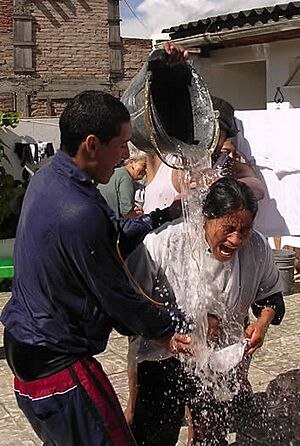
- Water Carnival
On December 28th, which is Holy Innocents' Day, some people in Pasto play with water. This is like a preview of the January carnival. It's similar to how people celebrate carnival in Ecuador, where water fun is common. What started as a day for jokes and pranks became a game of soaking unsuspecting people with water.
This custom isn't always popular, especially since Pasto's average temperature is only about 13°C (55°F). Authorities have tried to stop it. The local water company, Empopasto, found a clever solution. On that day, they cut off water supplies to the city for maintenance. This was like a big prank on the water players!
Since the late 1900s, other activities have been created. These offer fun and culture without the water. Examples include the "innocent tour" and the "rainbow on the asphalt."
- Rainbow in the Asphalt
In 1996, the "Rainbow in the Asphalt" event began. It was a cultural and eco-friendly alternative to the water carnival. Students from the University of Nariño started it. People use colorful chalk to draw on the gray streets. This helps bring back the fun and artistic spirit of the carnival. This pre-carnival event now focuses on art and a new way to celebrate the city.
New Year's Eve Puppets (December 31st)
On December 31st, Pasto's streets fill with dolls or puppets. These are made from old clothes, paper, and sawdust. They represent the "old year." At midnight, they are burned in a special ceremony. Kids ask for "alms for the old year." People dressed as "widows" (usually men) ask for money for a "decent burial" for the old year.
The main event is a puppet competition. The puppets are paraded through the streets. They often make fun of politics or important events from the past year. The best puppet creators win cash prizes.
The winning puppet is burned in the Carnival Plaza. This happens during the New Year's Eve party organized by the city. This is when the city truly starts to feel the playful spirit of the upcoming carnival.
Since 2006, selling fireworks has been banned in the city. Only the Mayor's office and Corpocarnaval can organize fireworks shows to welcome the new year.
Carnival Days
Tribute to the Virgin, Colonies Parade, and Rock Day (January 2nd)
Since 2000, January 2nd has been an official carnival day. It includes several new events:
- Tribute to Our Lady of Mercy
The Virgin of Mercy is like the protector of Pasto. She is usually celebrated on September 24th. But on January 2nd, farmers bring her flowers and sing to her. They ask for her blessing for the new year.
- Colonies Parade
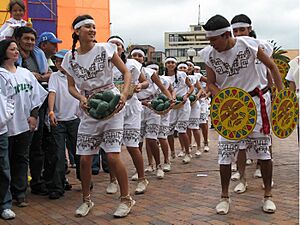
This parade features groups of people from different parts of the region or country. Each group shows off its unique culture and symbols. It's a chance to celebrate the diversity of the community.
- Pastorock
Pastorock is a music event. It features different styles like Blues, Rock en Español, Pop, Funk, Ska, and Heavy metal. This event has been part of the carnival for years. It has even inspired new music styles that mix rock with traditional sounds.
January 3rd is Carnavalito day. It started with children copying their parents' "Whites' Day" parade. Now, it's a big event with its own special feel. It has strong support from the community and authorities.
For about 40 years, children have had their own parade in the morning. They design and build mini-floats. This is how they learn to create the big floats for the main parade. As these young artists grow up, they eventually join the Great Parade on January 6th.
- Song to the Earth & Choreographic Collectives
A newer parade also takes place on January 3rd in the evening. It's a tribute to the Andes mountains, the land, and ancient memories. Large groups of musicians and dancers participate. Only the winners of this parade get to join the Great Parade on Whites' Day. It ends with a dance of friendship and a big Latin American music concert at the Liberty Stadium.
Arrival of the Castañeda Family (January 4th)
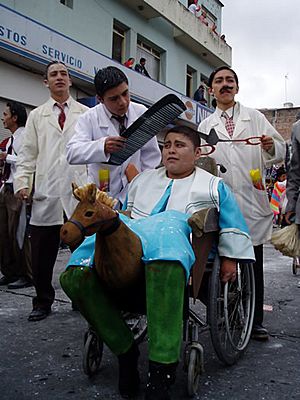
The main carnival parades begin on January 4th. This day celebrates the arrival of the "Castañeda Family." The story says this colorful family came to Pasto in 1929 from El Encano or the east of the country. No one knows for sure where they went next. Some say they were on a pilgrimage to the Las Lajas church.
Today, this family group is shown in the parade as a funny, cartoon-like family. They travel with all their luggage and cooking gear, ready to make food anywhere. They usually include a flashy grandmother, a daughter ready to marry, and mischievous children (often adults dressed as kids) who get into trouble.
The parade also features country dance groups and the ñapangas. These are women dressed in traditional costumes. Their image is a key part of the carnival.
Blacks' Day (January 5th)
January 5th is dedicated to Blacks' Day. This day remembers when African enslaved people were free to celebrate. People play and dance in the streets. They paint themselves black using special cosmetic creams, or sometimes polishes and black paint. The main saying for this day is: "¡Que vivan los Negros!" (Hurray for the Blacks!).
Traditionally, the Carnival Queen rides through the city. She hands out cosmetics and invites tourists to join the fun. She says: "¡Una pintica por favor!" (A little painting, please!).
This day is important because everyone in Pasto can let go and have fun. The black paint acts like a mask. It makes everyone look the same, no matter their social class or background. Everyone becomes one big family celebrating together.
Throughout the day, many music groups play in city parks. Local radio and TV stations visit artists' workshops. They try to get a sneak peek at the amazing figures being made for the floats on Whites' Day.
Whites' Day (January 6th)
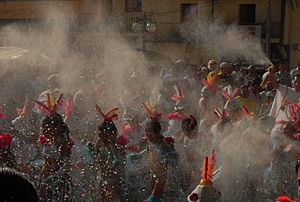
On January 6th, Pasto celebrates Whites' Day, not Epiphany. On this day, people paint themselves white, usually with fragrant talc powder. They use very little flour or other paints.
The main event is the Great Parade. It's almost 7 kilometers long and travels about 15 kilometers through the city center. It goes through the Plaza del Carnaval (Carnival Plaza) and along the "Carnival Path." Thousands of people, both locals and tourists, fill the streets to watch. They cheer, throw confetti or streamers, and dance to traditional songs. Famous songs include "The Guaneña," "El Trompo Sarandengue," and "The Southern Son." New songs are also played each year. The saying for this day is: "¡Que vivan los Blancos!" (Hurray for the Whites!).
The Great Parade (January 6th)
The Great Parade includes:
- Individual costumes: People dressed in unique outfits.
- Comparsas: Groups of artists in costumes who dance and travel through the streets.
- Murgas: Groups of many musicians playing together.
- Mini-floats: Smaller floats, up to 20 by 40 feet high. They are moved by hand or bicycle.
- Floats: Huge floats, up to 50 by 65 feet long. They are pulled by trucks or trailers. People can pay to ride on them in special costumes. These massive structures have large, moving figures or caricatures. Their design and detail make them true works of art. The carnival queen leads this part of the parade on her own float.
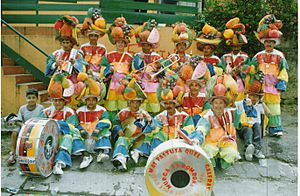
Artists spend about 4 months building a float because they are so detailed. They use techniques like paper mache and pasteboard. Recently, they've also started using fiberglass and light polymers. These materials help create amazing designs based on local myths, stories, and social ideas from Pasto's culture.
The event ends with awards for the parade participants. A group of national and sometimes international art experts judges the floats. They make sure the most original and beautiful floats win.
Rural Culture & Cuy's Festival (January 7th)
This day is the "finish" of the carnival. It's called "Cuy's Day" (Guinea Pig's Day). Locals and tourists enjoy the region's traditional dish, guinea pig. Many also visit the nearby Guamuez Lake and the rural fairs in Obonuco and Catambuco.
The Artisans or Carnival Cultores
The term "Carnival Cultores" is a new word. It combines "Culture" and "Actors." It mainly refers to the traditional "Carnival Artisans." But it also includes other people who participate in the parades in different ways.
The word "artisan" has been used for the people who create the floats. However, this doesn't include their families and partners who also help. Some people prefer "Cultores" or "Carnival Artists." These terms are more inclusive and show the professional and artistic value of their work.
The Carnival Cultores are organized into two main groups: Asoarca and Caminantes del Carnaval (Carnival Walkers). Asoarca is mostly for the float creators. Caminantes del Carnaval is for people who walk in the parades in costumes.
See also
 In Spanish: Carnaval de Negros y Blancos para niños
In Spanish: Carnaval de Negros y Blancos para niños
- Carnival in Colombia
- Festivals in Colombia
- Masterpieces of the Oral and Intangible Heritage of Humanity
- UNESCO Intangible Cultural Heritage Lists
- Afro-Colombian Day, Colombia
- Carnival



